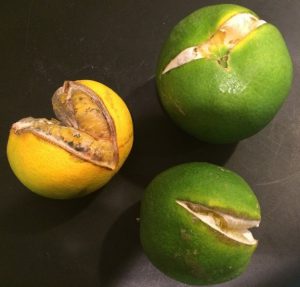We’re lucky to live an environment where many citrus varieties can be grown. However, many problems can occur when growing citrus, but none more frustrating than fruit drop or fruit split.
Most citrus varieties are susceptible to fruit drop. This is a major cause of low yield in the Navel orange industry. Quite a few variables can cause the condition. This can be difficult to pin point, however. Ethylene gas production goes into effect when a citrus tree is injured, which can spark fruit drop. Our culprit this year may be the late summer excessive periods of rain, high temperatures and areas of poorly drained soils. Low potassium is thought to also be factor in fruit drop, so be sure to follow a fertilizer schedule every year. Competition between fruitlets and young leaves for carbohydrates, water, and other metabolites can be the reason for fruit drop early in the season, as well.
Fruit drop can especially affect mature trees. This could mean up to 25% of fruit loss. Brown rot can accompany this condition, if moisture persists for long periods. Fruit drop is usually associated with the lower, shaded areas of the tree canopy.
Fruit split is more severe in Valencia, Hamlin and Navel oranges. Grapefruit (and other acidic fruits like lemons and limes), Tangerines and Temple fruit are much less susceptible. What is thought to be the primary cause of fruit splitting? High temperatures and heavy rainfall during August can easily give rise to the condition. Excess water taken up by a tree during this time will swell the meat of the fruit causing it to grow quickly. Unfortunately, it is believed that the peel does not grow at the same rate. Damage often occurs as the peel eventually caves under the pressure. Nutritional stresses early in fruit development can also be a factor, as low potassium and copper levels have been correlated. The condition is more likely to emerge when no irrigation practices were in place during dry periods that existed earlier in the year
If fruit split has been a problem this year, ensure a recommended fertilizer program next year. Proper tree siting, nutrition and irrigation scheduling are the best defense against fruit drop and fruit split. Although these measures are not a cure all for the conditions, a healthy citrus tree is less likely to be affected. Contact your local county extension office for more information.
Supporting information for this article is from the UF/IFAS Extension EDIS publication: “Citrus Problems in the Home Landscape” by Mongi Zekri and Robert E. Rouse: http://edis.ifas.ufl.edu/pdffiles/HS/HS14100.pdf & information is also provided by Extension Fruit Crop Specialist, Dr. Pete Andersen with IFAS located at Quincy, North Florida Research and Education Center.
UF/IFAS Extension is an equal opportunity institution.
- The Sunshine State is the Perfect Place for Sunflowers - July 20, 2025
- Why Are Sand Dunes & Sea Oats So Important? - March 20, 2025
- How to Care for a Gift Plant - December 5, 2024

